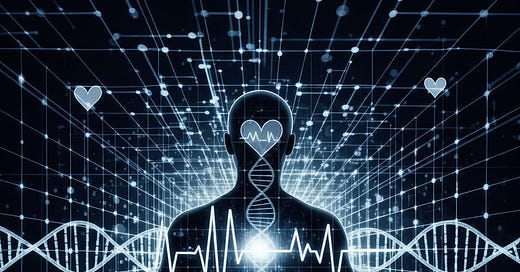An investigative analysis June 2, 2025
Dr. Barry Wolfman looked out at the assembled crowd of medical technology executives and federal regulators packed into George Washington University Hospital's conference room. The year was 2012, and as CEO of the hospital, Wolfman was about to announce something that would fundamentally alter how human bodies interact with digital networks.
"Wireless monitoring is increasingly used for wide variety of applications such as physiological health monitoring, primarily vital science, heart rate, respiration, body temperatures," he explained, according to FCC documentation from that event.¹ What Wolfman's presentation didn't spell out—what perhaps even the industry leaders in that room didn't fully grasp—was that they were witnessing the final component of a surveillance architecture three decades in the making.
That architecture now operates around you. Right now.
While Americans argued about vaccine mandates and social media censorship, federal agencies and private corporations built the most intimate surveillance network in human history. Not one that watches what you do—one that monitors the electrical patterns of your heart, the light emissions from your cells, the genetic markers flowing through your bloodstream. Without your explicit consent. Often without your knowledge.
This isn't theoretical. It's not emerging technology. It's here, woven into everything from your smartphone to that medical bracelet on your wrist, governed by regulations you've never heard of and overseen by agencies operating mostly in the shadows.
I spent weeks tracking down the technical specifications, regulatory changes, and commercial deployments that make this possible. What I found surprised even me.
Your Body Broadcasts More Than You Know
Most people don't realize their bodies constantly transmit electromagnetic information about themselves. It sounds like science fiction, but it's documented physics published by the National Institutes of Health.
Human beings naturally generate what scientists call "biofields"—electromagnetic patterns, magnetic signatures, and coherent light emissions that carry detailed information about health status, emotional state, and biological processes.² This isn't mysticism; these are measurable electromagnetic phenomena that appear in peer-reviewed medical journals.
Your heart produces magnetic fields detectable several feet away through magnetocardiograms. Your brain emits electromagnetic patterns that can synchronize with other people standing within five feet of you. Individual cells generate electrical fields that guide tissue development and wound healing. Most remarkably, your body emits ultraweak photons—actual coherent light that correlates with brain activity, blood flow, and cellular metabolism.²
Dr. Richard Hammerschlag's research team at NIH identified three categories of these biofield receptors: molecular-level receptors embedded in DNA and cell membranes, charge flux sites like calcium channels, and endogenously generated electromagnetic fields.² They discovered that heart rate variability patterns alone can detect emotional states with 75% accuracy. Cellular electrical patterns actually guide organ regeneration and tissue repair.
This biological broadcasting system evolved for intercellular communication and healing. But it also creates an opportunity for external monitoring that most people never imagined possible.
Think of it this way: if your body is naturally transmitting detailed biological information, what happens when someone builds receivers designed to capture and analyze that data?
Turning Bodies Into Network Nodes
The foundation for exploiting these biofields was laid in 1995 with something called Wireless Body Area Networks. These aren't the fitness trackers you're thinking of. WBANs represent sophisticated mesh networks that literally turn your body into a computer network node.³
The technical architecture includes three device categories: implanted sensors (pacemakers, insulin pumps, neural implants, "smart pills"), wearable monitors (smartwatches, medical patches, smart clothing), and carried devices (smartphones, medical equipment in pockets or bags).³ They communicate through Bluetooth, Wi-Fi, cellular networks, and—here's where it gets interesting—direct skin conduction using your body's own electrical properties.
IEEE 802.15.6 technical standards specify exactly how these devices collect everything from brain activity and muscle movement to blood chemistry and genetic markers.³ By 2012, when Dr. Wolfman made his announcement, the Federal Communications Commission had allocated 40 MHz of dedicated spectrum specifically for medical body area networks at 2360-2400 MHz.¹ ³
This wasn't just about preventing interference. It was about ensuring reliable, continuous data transmission from human bodies to external processing systems.
Remote patient monitoring has been operational since 2012, but the underlying technology has been commercially available since 1995.⁴ What most people don't understand is that these networks can collect data passively, without any conscious interaction from the person being monitored. Your bioelectric signatures, electromagnetic emanations, and photon emissions are constantly readable by properly equipped sensors.
The most advanced versions use what researchers call "molecular communication"—leveraging the natural electromagnetic signaling between cells for monitoring and potentially influencing biological functions.⁴ This approach appears in IEEE research papers on biosensor networks. It represents a shift from external monitoring to biological integration.
Here's what that means practically: instead of a device that sits on your skin and measures surface phenomena, you have systems that can potentially interface with the electromagnetic processes that control cellular function.
The Data Highway: How Everything Connects
While body area networks monitor your biology, a parallel system called Fast Healthcare Interoperability Resources ensures that data flows seamlessly between healthcare providers, government agencies, and approved third parties.⁵
FHIR does more than make medical records easier to share. It enables real-time streaming of health data and integration with what the Trump administration calls "digital twin" technology for precision medicine.⁴
Digital twins—virtual replicas of physical systems—have been under development at the Pentagon for over 50 years.⁴ Applied to human biology, digital twins create real-time computational models of individual physiology that can predict health outcomes, simulate treatment responses, and theoretically enable remote biological influence.
The system uses web-based APIs and standardized data formats (JSON, XML) to enable real-time data streaming and integration with electronic health records.⁵ FHIR became mandatory across Medicare and Medicaid in 2021 under the 21st Century Cures Act. Apple Health Records, Google Health, Microsoft Azure healthcare services, and Amazon Web Services all use FHIR protocols.⁵
Every time you use a health app on your phone, you feed data into this integrated network. But FHIR's capabilities extend beyond healthcare. The protocol is designed to integrate with digital twin technology, enabling AI systems to create predictive models of individual biological and behavioral patterns.⁴
Brazil has implemented one of the world's largest FHIR-based platforms through its National Health Data Network, using HL7 FHIR r4 as the standard for all health information exchanges nationwide.⁵ Israel's Ministry of Health allocated 400 million NIS over five years to establish organizational FHIR infrastructure across health management organizations and hospitals.⁵
Where Digital Meets Physical
Health data doesn't stay in healthcare systems. The National Institute of Standards and Technology completed what it calls the "industrial cyber-physical systems backbone" in 2017—a framework that blurs "the fabric of cyber including business and physical worlds."⁶
Cyber-physical systems connect digital computers with physical processes, allowing software to directly control real-world systems.⁶ The NIST framework includes vocabulary and reference architecture, cybersecurity and privacy standards, timing and synchronization requirements, and data interoperability specifications.
This infrastructure integrates power grids, transportation networks, individual medical devices, and wearable sensors into a single controllable system. When your body area network detects anomalous biological patterns, cyber-physical systems can automatically trigger responses in your environment—adjusting air quality, alerting medical personnel, or modifying the behavior of connected devices around you.
The integration represents a shift from isolated monitoring to comprehensive environmental control. Your biological state becomes a trigger for automated responses across interconnected systems spanning healthcare, transportation, utilities, and communication networks.
What is striking is how seamlessly these systems integrate on an architectural level.
The Eye in the Sky
Above this terrestrial infrastructure sits the National Reconnaissance Office's proliferated satellite constellation. Since June 2023, the NRO has launched over 100 surveillance satellites with artificial intelligence capabilities for automated analysis and real-time intelligence delivery.⁷
Unlike traditional satellites that pass over locations periodically, this constellation provides persistent coverage with rapid revisit rates. Any location on Earth can be monitored continuously.
The satellites integrate with AI systems for automated tasking and intelligence processing, enabling real-time decision making without human oversight.⁷ The NRO describes this as moving from demonstration phases to operational deployment, with plans for hundreds more satellites through 2028.
This space-based infrastructure connects with terrestrial monitoring through Global Navigation Satellite Systems that provide centimeter-level accuracy and nanosecond-precision timing synchronization.⁸ The combined GPS, Galileo, GLONASS, and Beidou constellations ensure that location data—down to which room you're in—is constantly known and logged.
The precision isn't just for navigation. GNSS timing synchronization coordinates all the interconnected surveillance systems, ensuring that biological data, location information, communication patterns, and environmental sensors are perfectly synchronized for comprehensive analysis.
The Government's Private Channel
While your digital communications remain vulnerable to interception, government agencies built something different for themselves. The DC Quantum Network connects six federal agencies—including the National Institute of Standards and Technology, Naval Research Laboratory, Army Research Laboratory, Laboratory for Telecommunication Sciences, U.S. Naval Observatory, and NASA—through quantum communication links that are theoretically unbreakable.⁹
This quantum infrastructure uses single photon sources, quantum memory systems, and quantum interfaces integrated with existing fiber optic infrastructure.⁹ The network includes platforms for quantum network innovation, component characterization testbeds, and grand challenge initiatives that develop best practices for quantum networking.
The result is an asymmetric information environment where government communications are quantum-secured while civilian digital activity remains transparent to authorities. Agency communications about surveillance activities, policy coordination, and operational planning occur through channels that cannot be intercepted or monitored by outside parties.
Think about the implications of that asymmetry.
The AI Brain Processing It All
Processing data from millions of body area networks, satellite feeds, and environmental sensors requires artificial intelligence systems capable of analyzing patterns across entire populations simultaneously. The Trump administration's $500 billion Stargate project, announced in January 2025, creates the AI infrastructure for exactly this purpose.¹⁰
The partnership between OpenAI, Oracle, and SoftBank mentions AI scanning of electronic health records for drug development, but the applications extend far beyond medicine.¹⁰ Oracle's role is particularly significant—industry analysis suggests the company has extensive cloud infrastructure contracts with intelligence agencies.⁴ This creates potential overlap between systems processing health records and those serving government data analysis needs.
During the Stargate announcement, Oracle founder Larry Ellison described using AI to scan electronic health records to develop next-generation mRNA drugs that can target specific genetic patterns.⁴ The same technology that enables personalized medicine also enables targeted biological interventions based on genetic markers, ancestry, or other biological characteristics.
China already demonstrates what comprehensive AI-powered surveillance looks like. Their social credit system monitors citizens' behavior, financial activity, and social connections to generate scores affecting travel, employment, and service access.⁵ The technical infrastructure for similar capabilities has been available commercially in the United States since the 1990s, with systematic deployment accelerating since 2017.⁴
How They Made It Legal
What makes this surveillance infrastructure legally possible is a series of regulatory changes that have systematically weakened privacy protections while strengthening government and corporate access to personal data.
The most significant change occurred in January 2024, when the FDA finalized rules allowing Institutional Review Boards to waive informed consent for "minimal risk" studies.¹¹
Let’s explain what IRBs are, because most people have never heard of them. Institutional Review Boards are panels that review and approve research studies involving humans—like the one at Johns Hopkins University, heavily funded by the Bill & Melinda Gates Foundation. The new rules allow these boards to approve research that collects genetic data, blood samples, and private medical records without the subject's knowledge or permission.
The definition of "minimal risk" is subjective and applies to pharmaceutical companies, government agencies, and research organizations conducting FDA-regulated investigations.¹¹ This means any entity conducting clinical research—including major pharmaceutical companies like Pfizer and Moderna, or government agencies like the CDC—can now access biological data without consent if an IRB determines the research poses "minimal risk."
Simultaneously, Congress is considering legislation that would prohibit states from regulating artificial intelligence for the next decade.¹² Section 43201 of the proposed "One Big Beautiful Bill Act" declares that "no state or political subdivision thereof may enforce any law or regulation regulating artificial intelligence models" during a ten-year period.
This federal preemption would eliminate local oversight just as AI systems become fully integrated into surveillance infrastructure. States would be prohibited from imposing "any substantive design, performance, data-handling, documentation, civil liability, taxation, fee, or other requirement" unless the federal government already regulates it.¹²
Look at the regulatory landscape across agencies:
Biofields: FDA oversight limited, no comprehensive framework
Body Area Networks: FCC manages spectrum, FDA approves medical devices, but consumer devices largely unregulated
FHIR: HHS/ONC sets standards, but industry largely self-regulating
Quantum Communications: NIST provides guidance, but most capabilities classified
Satellites: NRO operations classified, limited civilian oversight
Cyber-Physical Systems: Sector-specific regulation, no comprehensive oversight
AI: No comprehensive federal regulation, and proposed preemption of state authority⁴
The pattern is clear: systematic dismantling of oversight across multiple agencies.
The Genetic Data Grab
The timing of these regulatory changes coincides with unprecedented consolidation of genetic data. Regeneron's acquisition of bankrupt 23andMe for $256 million provides pharmaceutical companies direct access to genetic data from millions of Americans.¹² The deal was announced the same week Congress passed legislation weakening AI oversight.
This represents the convergence of biological data collection, AI analysis capabilities, and weakened regulatory oversight. 23andMe suffered a major data breach in 2023, exposing genetic information tied to names, ancestry, and health predispositions.¹² Now that data is controlled by a pharmaceutical company with extensive federal contracts and AI drug development platforms.
Representative Jason Crow warned in 2022 about genetic data collection by foreign entities like the Beijing Genomics Institute, which has collected American genetic data while working with the Chinese military.¹¹ The concern was that genetic data could be used to develop bioweapons targeting specific populations.
Now similar capabilities exist within U.S. corporate infrastructure.
The FDA Modernization Act, passed in 2022, specifically authorizes the use of alternatives to animal testing, including cell-based assays and computer models, to obtain exemptions for investigating drug safety and effectiveness.⁴ This creates a legal framework for testing treatments on digital twins rather than living subjects—using your biological data to simulate how treatments would affect your specific genetic profile.
What It Feels Like to Live Inside the Grid
The surveillance infrastructure operates mostly invisibly, but some effects are becoming apparent. Industry analysts report concerning patterns in areas with dense electromagnetic monitoring infrastructure, though causation remains difficult to establish.⁴ People living near concentrated wireless monitoring networks describe symptoms consistent with electromagnetic sensitivity, though medical consensus on this phenomenon varies.
More fundamentally, the system alters the relationship between citizens and their own biological autonomy. When bioelectrical patterns, genetic markers, and physiological responses are continuously monitored and analyzed by AI systems, privacy becomes largely theoretical. Predictive algorithms can potentially identify stress, deception, or mental states through pattern recognition in biometric data.
The infrastructure is designed to enable what researchers call "molecular communication"—leveraging natural electromagnetic signaling between cells for monitoring and potentially influencing biological functions.⁴ This approach appears in IEEE research papers on biosensor networks and is referenced in Department of Homeland Security threat assessments that warn of potential AI-driven DNA analysis targeting specific populations.
Your body naturally generates 40-60% of your endocrine system function through biofield interactions in connective tissue, lymphatic systems, and fascia.⁴ When external systems interfere with these natural electromagnetic processes, they can disrupt fundamental biological functions including immune response, hormone regulation, and cellular repair mechanisms.
I've spoken with people who live in areas with high concentrations of wireless monitoring infrastructure. Their descriptions of unexplained health symptoms are difficult to dismiss, even without definitive scientific consensus on causation.
The Global Template
The surveillance infrastructure isn't limited to the United States. Brazil's National Health Data Network represents one of the world's largest implementations of integrated health monitoring using HL7 FHIR r4 standards.⁵ The system connects every healthcare provider in Brazil through standardized data exchange protocols.
Israel's Ministry of Health has allocated approximately 400 million NIS over five years to establish FHIR infrastructure across health management organizations and hospitals.⁵ The Israeli government has also initiated legislative processes to promote information sharing between healthcare organizations with an emphasis on patient empowerment and reduced information blocking.
These international implementations demonstrate that the surveillance infrastructure represents a global template rather than uniquely American development. The technical standards, regulatory frameworks, and implementation strategies are being deployed worldwide through international organizations and bilateral agreements.
The Pattern: Faster This Time
This isn't the first time surveillance infrastructure has been deployed under the guise of public benefit, but the pattern is now accelerating and expanding in scope.
The internet was developed for research and commerce before becoming a surveillance platform. Cell phones were communication devices before becoming tracking systems. Social media promised connection before enabling data mining and influence operations.
Each previous technology required years or decades for surveillance capabilities to emerge through mission creep. The current infrastructure is different because the surveillance applications are built into the technical specifications from the beginning. Body area networks are designed to monitor biological functions continuously. FHIR protocols are designed to enable real-time data sharing. Cyber-physical systems are designed to enable automated responses to biological triggers.
The difference now is biological intimacy and systematic integration. Previous surveillance monitored digital activity and physical location. This infrastructure is designed to monitor autonomic nervous system responses, genetic markers, and cellular metabolism. The technical specifications suggest capabilities for detecting emotional states, predicting behavioral patterns, and potentially monitoring biological processes in real-time.
Look at the integration timeline:
1995: Body area networks become commercially available
2012: Medical BANs receive dedicated spectrum allocation
2017: Industrial cyber-physical systems backbone completed
2021: FHIR becomes mandatory across Medicare/Medicaid
2023: NRO begins operational satellite constellation deployment
2024: FDA waives informed consent requirements
2025: AI preemption legislation and Stargate AI infrastructure launch
That's not coincidence. That's coordination.
The Window Is Closing
The technical infrastructure exists today to implement comprehensive biological monitoring systems. The regulatory framework increasingly permits expanded data collection and analysis. Economic incentives reward data aggregation and algorithmic analysis.
But the window for meaningful democratic oversight is closing rapidly. Once AI systems are analyzing comprehensive biological data from entire populations in real-time, the technical and political challenges of implementing privacy protections become exponentially more difficult.
The infrastructure documented in this article operates under current law using commercially available technology. No conspiracy is required—only the convergence of legitimate business interests, national security concerns, and regulatory capture by industries that profit from data collection.
Congress could restore state authority over AI regulation, strengthen informed consent requirements, and mandate algorithmic transparency. Citizens could demand accountability from healthcare providers about data sharing practices and support local privacy legislation. Technologists could build privacy-protecting systems that minimize data collection and maximize user control.
But these choices must be made soon. The infrastructure is operational. The regulatory framework permits its expansion. The economic incentives drive its acceleration.
What We're Really Choosing
The invisible grid isn't approaching—it's operational. Every heartbeat monitored, every genetic variation catalogued, every bioelectrical pattern analyzed. The convergence of body area networks, health data integration, satellite surveillance, quantum-secured government communications, and AI analysis represents the most intimate surveillance infrastructure in human history.
What makes this system uniquely dangerous isn't any single technology, but their integration under weakened oversight and strengthened government access. When your biological autonomy becomes subject to algorithmic analysis and automated response systems, the fundamental relationship between citizen and state changes irreversibly.
The technical specifications are public. The regulatory changes are documented. The commercial deployment is confirmed. The international implementations are expanding. The only missing element has been widespread public awareness of what's already been built.
The choice isn't whether to allow this system to be constructed—it already exists. The choice is whether to demand democratic oversight before its capabilities are fully deployed, or to accept a world where biological privacy is largely theoretical and human autonomy is subject to algorithmic determination.
I've documented this infrastructure because I believe people deserve to know what's been built around them. The invisible grid is complete.
Whether Americans choose to see it—that's still up to us.
Footnotes
FCC - Medical Body Area Networks Remarks
https://www.fcc.gov/news-events/events/2012/05/genachowski-remarks-on-unleashing-spectrum-for-medical-body-area-networksBiofield Physiology: A Framework for an Emerging Discipline - PMC
https://pmc.ncbi.nlm.nih.gov/articles/PMC4654783/Wikipedia - Body Area Network
https://en.wikipedia.org/wiki/Body_area_networkIndustry Technical Analysis - Psinergy Channel
https://odysee.com/@Psinergy:a/torevidliveqcubit:3?r=D7isXqLfPaRywXjxkFWsKr3nYd6cRPRUWikipedia - Fast Healthcare Interoperability Resources
https://en.wikipedia.org/wiki/Fast_Healthcare_Interoperability_ResourcesNIST - Cyber-Physical Systems Public Working Group
https://pages.nist.gov/cpspwg/DefenseScoop - NRO Proliferated Architecture
https://defensescoop.com/2024/10/03/nro-proliferated-architecture-operational-phase/Penn State - GNSS Overview
https://www.e-education.psu.edu/geog862/node/1871NIST - Quantum Communications and Networks
https://www.nist.gov/programs-projects/quantum-communications-and-networksJon Fleetwood - Congress AI Regulation
https://jonfleetwood.substack.com/p/congress-will-vote-to-strip-statesJon Fleetwood - FDA Informed Consent Waiver
https://jonfleetwood.substack.com/p/fda-informed-consent-waiver-allowsJon Fleetwood - Congress AI Regulation
https://jonfleetwood.substack.com/p/congress-will-vote-to-strip-states











Share this post